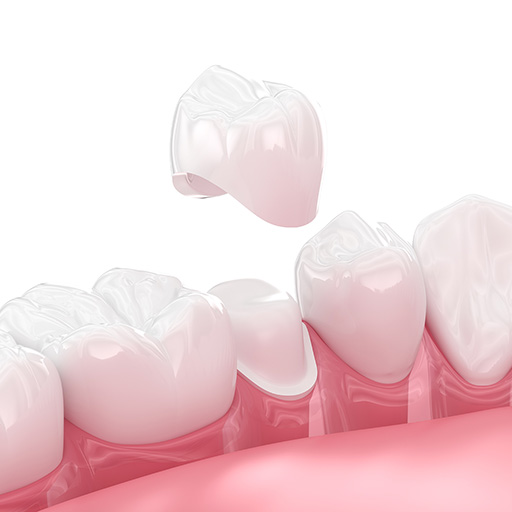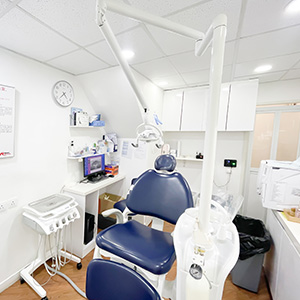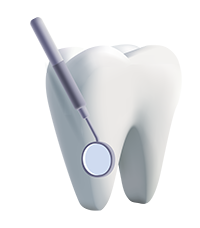Dental Crowns And Bridges
Home > Oral Services > Advanced Dental Treatment – Dental Crowns And Bridges

Dental Crowns And Bridges
Dental crowns and bridges are some of the best options if you are missing one or more teeth. Prosthetic devices are used in both dental bridges and dental crowns to restore your smile. A crown is used when a tooth is broken or fractured, whereas a tooth bridge is used when one or more teeth are missing.
1. Dental Crown
Functions and Characteristics Of Dental Crowns:
- Provide protection to a tooth and prevent tooth fracture. They are commonly used for treating cavities, cracked teeth, severely damaged or extensively filled teeth, or teeth that have undergone root canal treatment.
- Restore the shape of the tooth and restore normal chewing function.
- Improve the appearance of the tooth in terms of color, shape, and size.
- Serve as a support for dental bridges.
Different Types Of Dental Crown Materials And Characteristics:
- Full Porcelain
- Porcelain crowns are quite thin, completely cover the tooth, and also have a color that is as close to natural as possible.
- More resistant to staining than natural teeth.
- More brittle than alloys, prone to cracking, requires more tooth reduction to ensure proper thickness of the orthodontic appliance
- Suitable for patients who prioritize the appearance of their teeth
- Porcelain Fused To Metal Crowns (Porcelain + Alloy)
- Aesthetic porcelain surface, color matching natural teeth
- Strong and durable due to the alloy base
- Durable material
- Requires a certain thickness and partial tooth reduction
- Gray or black at the gum line can be present if the border (or margin) of the crown is exposed.
- Suitable for both front and back teeth.
- Full Metal
- Strong and highly durable
- Requires thinner thickness, only slight reshaping of natural teeth needed
- Metallic color doesn’t give it an aesthetically pleasing look
- Suitable for posterior teeth that need to withstand strong biting forces.
- Stainless Steel
- Standard size orthodontic appliance, not custom-made.
- Shorter production time and simpler treatment process due to not being individually tailored to each tooth.
- Silver-colored, less aesthetically pleasing
- Relatively easy to install
- The crown edges may not perfectly fit. Therefore, it prones to have plaque accumulation, which may lead to tooth decay, gum inflammation, and periodontal diseases in the long run.
- Suitable for deciduous molars.
The Process Of Fitting Dental Crown
- Grinding the surface of the tooth.
- Taking impressions and recording the bite position.
- Applying a temporary crown to the reshaped tooth.
- Manufacturing the dental crown in a dental laboratory.
- Removing the temporary crown, cleaning the tooth, installing the dental crown about after 1-2 weeks the first visit.
- Fixing the crown onto the tooth using adhesive.
Q&A
- When Is It Suitable To Have A Dental Crown?
- Things To Consider When Getting Dental Crown?
- How To Care For Your Temporary Crowns?
- Severe tooth breakage or missing teeth
- Severe tooth decay that cannot be treated effectively with fillings alone
- Teeth that have become brittle, such as those that have undergone root canal treatment
- Dissatisfaction with the appearance of traditional dentures and a desire to improve issues like black gums
- Dental issues such as enamel demineralization, fluorosis, etc.
- Tooth discoloration due to tetracycline
- If temporary dental crown become loose, contact your dentist promptly as changes in tooth position may affect the final placement of the dental crown.
- During the tooth preparation process, there may be irritation or the risk of pulp infection, leading to temporary tooth sensitivity or weakness. If symptoms persist or worsen, seek immediate dental care.
- After the dental crown placement, the shape may slightly differ from your original teeth, and it may take some time to adapt.
- Maintain good oral hygiene habits, regularly clean your teeth and gums, and have routine dental check-ups.
While waiting for your permanent crowns to be done, take the following precautions to prevent temporary crowns from loosening:
- Avoid eating sticky and hard-to-chew foods, such as gum, to prevent sticking to the temporary crowns.
- Try to avoid chewing food with temporary crowns, and move most of the chewing to the other side of the mouth if possible.
- Avoid chewing hard foods to prevent the temporary crowns from shifting or getting damaged.
- Brush your teeth regularly to maintain oral hygiene.
2. Dental Bridge
A dental bridge is a restoration method used to fill the gap left by missing teeth. By grinding down the teeth adjacent to the missing teeth to form abutments, a bridge is created to support the artificial tooth (pontic) in the middle. The dental bridge, consisting of the artificial tooth (pontic) and crowns on both ends, is fixed in the place of the missing teeth. Dental bridges can restore biting function, prevent adjacent teeth from shifting, and enhance oral aesthetics.
Q&A
- What Are Advantages & Disadvantages of Dental Bridges?
Advantages of Dental Bridge:
- Restore chewing and speech function. It provides a strong, durable, and comfortable solution.
- A cost-effective solution for replacing missing teeth.
- Dental bridges are more permanent than dentures and partial dentures, and do not have to be removed at night or for cleaning.
Disadvantages of Dental Bridge:
- It requires the alteration and preparation of adjacent healthy teeth to support the bridge, which may weaken them.
- It is more difficult to clean. The risk of decay increases, as cleaning around the crowns may be more difficult, potentially leading to complications over time.
- It must be replaced every 10 to 15 years.










